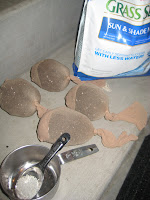Thankfully, one very smart author does. Mary Firestone wrote
a wonderful book that’s full of great facts about these amphibians and, not
only was it instrumental in answering my son’s question, but its painted
illustrations captivated us both.
Reading Firestone’s book taught us the following:
- Frogs have a slimmer body than toads.
- Their legs are longer too.
- Toads have bumpy skin, whereas a frog’s skin is smooth.
- Frogs can be found in water, trees, and on land. Toads stick to the ground.
- Some frogs have webbed toes on their back feet; toads don't.
Once he got it all straightened out, he painted each. To make the frog’s body slick, we covered it in packaging tape. To make the toad’s body wart-like, he sprinkled lentils over white school glue. The legs were attached with brads.
Lastly, I gave him two pieces of cardstock that said “A frog lives ….” and “A toad lives …” and asked him to finished the sentences. Then, he painted their habitats.
My son refused to glue down his frog and toad because “then they won’t be able to jump, Mom!” A sticky dot of Velcro behind each was the perfect solution!
When Daddy got home from work that night, my son showed him the pictures and pointed out all the differences between his frog and toad. Now no one in our family is clueless about what sets these two amphibians apart!






































